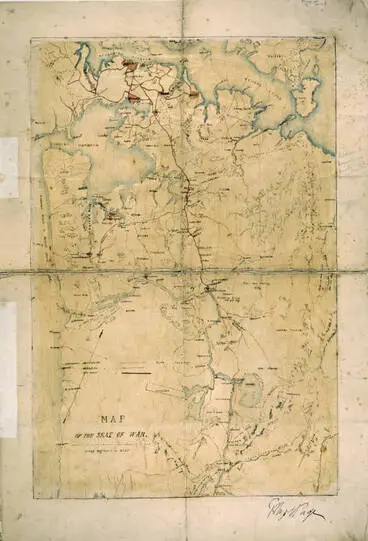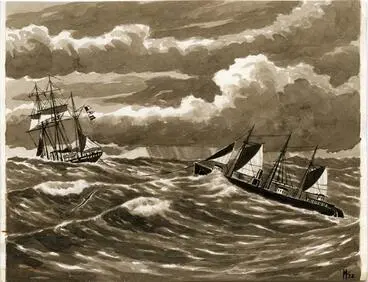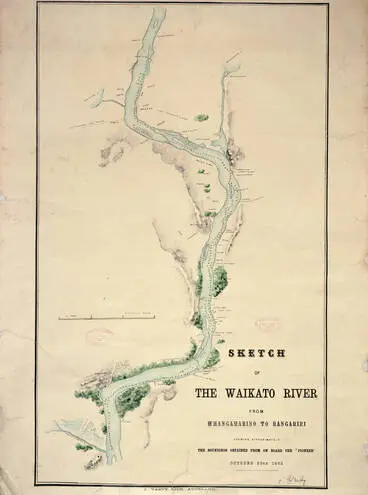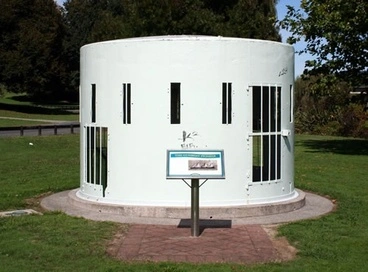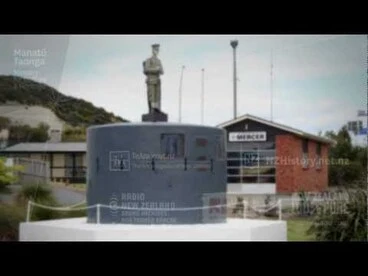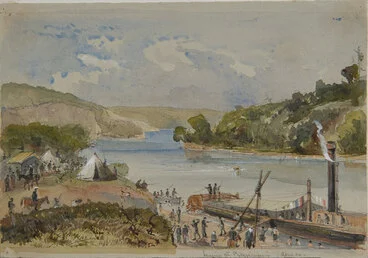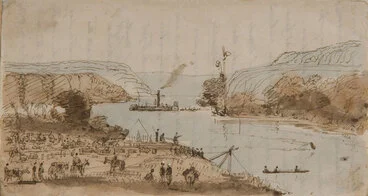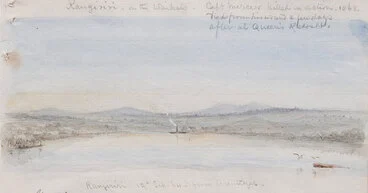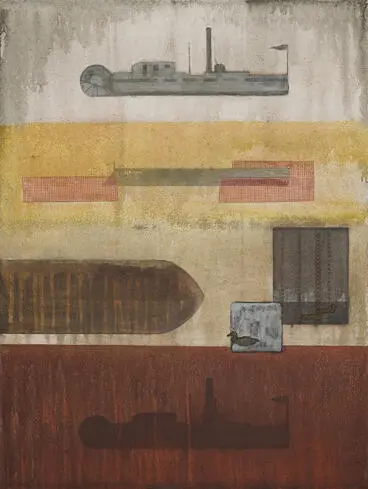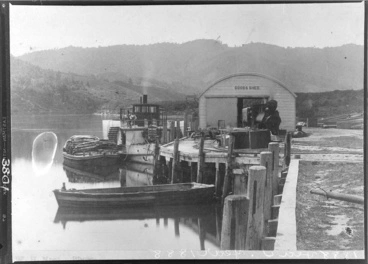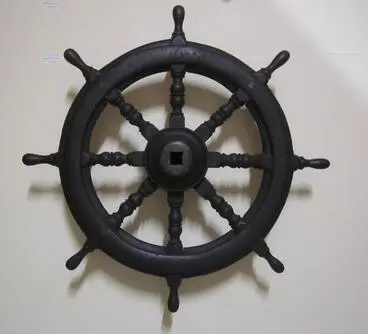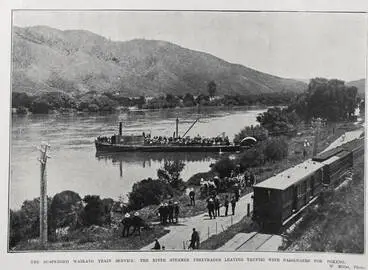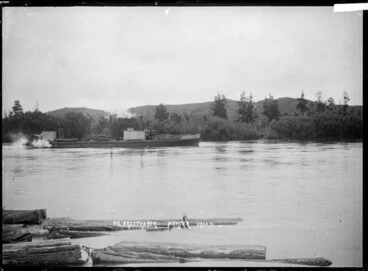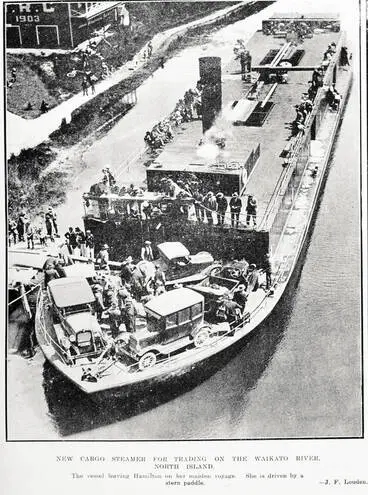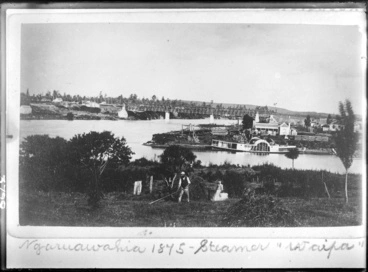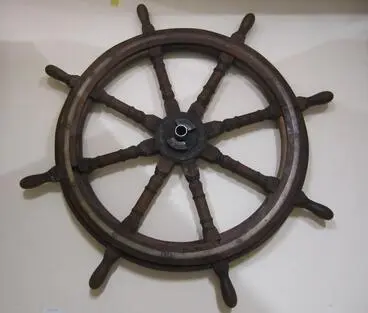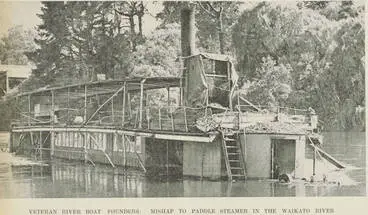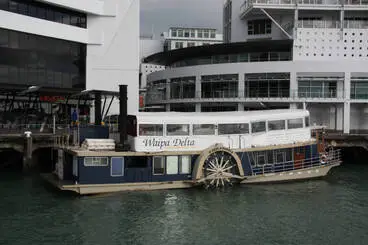Paddle steamers on the Waikato River
A DigitalNZ Story by Zokoroa
A history of paddle steamers on the Waikato River. These riverboats were used as gunboats during the Waikato Land Wars (1863 - 1864), and to transport passengers and cargo. In recent years, a replica was used as a floating restaurrant.
Paddle steamers, Paddlesteamer, Paddle boat, Paddle boats, Steamer, Steamboat, Boats, Gunboats, Riverboats, Waikato Wars, Maori Wars, Land Wars, New Zealand Wars, Royal Navy, Navy, Transport, Waikato River, Hamilton, Cambridge, Ngaruawahia
1. INTRODUCTION
Hands up who remembers having a cruise on the Waipa Delta! Built in Tauranga in 1985 as a tribute to the paddles teamers Waipa and Delta, this replica was a floating restaurant for sightseers along the Waikato River. This 'story' is a history of the paddle steamers that were used as gunboats during the Waikato Land Wars and to transport passengers and cargo over the years along the Waikato River.
Backhouse, John Philemon, 1845-1908 :[River steamer and bridge on the Waikato. 1880]
Alexander Turnbull Library
2. GUNBOATS DURING WAIKATO LAND WARS: July 1863 - April 1864
During the Waikato Land Wars, three paddle steamers – Avon, Pioneer and Koheroa – were modified or built as military transport by the New Zealand Colonial Government. They were used to move the troops and supplies past the Māori fortifications along the Waikato River and Waipā River. These steam vessels, commonly known as the ‘Waikato Flotilla’, were used to outflank the Māori positions at Meremere and Rangiriri, and to capture Ngāruawāhia. For a summary of the role the vessels played and the navigational difficulties encountered on the riverbanks, see the National Museum of the Royal New Zealand Navy. For an outline drawing of the gunboats, see Waikato river gunboats 'The ironclads".
Map of the seat of war
Auckland Libraries
STEAM BARGES FOR THE WAIKATO. (Daily Southern Cross, 22 October 1863)
National Library of New Zealand
Video excerpt on the invasion of the Waikato, including the gunboat patrols
The New Zealand Wars - Episode 3, The Invasion of the Waikato
NZ On Screen
River Gunboat "Avon" - a paddle-wheel iron steamboat
The Avon, which had been trading in Lyttelton, was purchased by the New Zealand Government to use as a troopship. The vessel was 60 feet in length and weighed 40 tons. It was refitted at Onehunga in 1862 with iron-plates in its bulwarks, a Congreve rocket tube, and a 12-pounder Armstrong gun in its bows. In addition, four armoured barges (30 to 35 feet in length) were prepared for towing troops. Another vessel, the ‘Gymnotus’ was used for carrying stores. The Avon was towed to the Waikato Heads on 25 July, 1863, by the H.M.S. “Eclipse". (Source: New Zealand History: Pioneer turret NZ Wars memorial, Ngāruawāhia) As the Avon had reduced armour, she was deployed on the Waipā River in January 1864.
LAUNCH OF THE STEAMER AVON. (Lyttelton Times, 11 February 1860)
National Library of New Zealand
Decision made to purchase the Avon to operate in the Waikato
THE WAIKATO STEAMER. (Daily Southern Cross, 08 December 1862)
National Library of New Zealand
THE AVON IN THE WAIKATO. (Wellington Independent, 04 August 1863)
National Library of New Zealand
THE STEAMER AVON FIRED ON AT THE WAIKATO. (Colonist, 11 September 1863)
National Library of New Zealand
THE WAR IN AUCKLAND. UP THE WAIKATO (FROM OUR SPECIAL CORRESPONDENT.) (Daily Southern Cross, 31 August 1863)
National Library of New Zealand
The Avon arrives at Te Rore
Auckland. THE NATIVE REBELLION.—THE LATEST MOVEMENTS. (From the New Zealand Herald, Feb. 2.) (New Zealand Spectator and Cook's Strait Guardian, 1...
National Library of New Zealand
Watercolour of unnamed paddle steamer moored at Te Rore near several tents & soldiers, 1864
As the Avon had less armour than the Pioneer & Koheroa, she was deployed on the Waipā River in January 1864.
Alexander Turnbull Library
Troops and supplies were transported by the gunboats
Camp at Rahui Pokeka New Zealand
Auckland War Memorial Museum Tāmaki Paenga Hira
THE 'AVON' AND 'KOHEROA.' (Daily Southern Cross, 15 February 1864)
National Library of New Zealand
THE 'AVON' FIRED UPON.-LIEUT. MITCHELL WOUNDED. (FROM OUR OWN CORRESPONDENT.) (Daily Southern Cross, 01 March 1864)
National Library of New Zealand
River Gunboat "Pioneer" - a stern-wheeled paddle steamer
This vessel was purpose-built for the New Zealand Government in 1863 by the Sydney-based Australian Steam Navigation Company. Originally named Waikato, the name was changed to Pioneer after arriving in NZ on 3 October.
The Pioneer was a flat-bottomed, stern-wheeled paddle-steamer, 43 m long with a 6 m beam, and weighed 304 tons. It was modified in Onehunga with two revolving iron turrets measuring 2.4 m high and 3.6 m in diameter. Positioned fore and aft, the turrets protected 12-pounder Armstrong guns and provided loopholes for troops firing rifles and small arms. Powered by twin 30 hp engines and a 3.7 m (12 ft) stern wheel, the Pioneer could reach a top speed of 9 knots (17 kph).
The River Gunboat “Pioneer”
Victoria University of Wellington
STEAM GUNBOAT AT THE WAIKATO. (Wellington Independent, 21 July 1863)
National Library of New Zealand
Chief Te Wheoro visiting on board the Pioneer (1863)
The friendly chief Te Wheoro & his followers onboard H.M.S Pioneer
Auckland War Memorial Museum Tāmaki Paenga Hira
On 31 October 1863, 600 men of the 40th and 65th regiments boarded the Pioneer, the Avon and the four barges, which were towed by two steamers. The convoy was fired at as it steamed past Meremere before landing ten kms upriver. However, the metal plating largely protected the vessel: "While one round penetrated plating and spoiled a barrel of beef, Pioneer was largely undamaged." (Source: New Zealand History). The following day the British occupied the abandoned pā.
The Pioneer bombards a Māori pā at Meremere
Illustrated London news :The war in New Zealand. The gunboat Pioneer at anchor on the Waikato River, reconnoitring the native positions. Illustrate...
Alexander Turnbull Library
The Fight At Rangiriri - The Cyclopedia of New Zealand [Auckland Provincial District]
Victoria University of Wellington
Gunboat and Maori Cannoneers - The New Zealand Railways Magazine, Volume 3, Issue 2 (June 1, 1928)
Victoria University of Wellington
THE ' PIONEER ' AT RANGIRIRI. (Taranaki Herald, 14 November 1863)
National Library of New Zealand
Heaphy, Charles, 1820-1881: Mere-Mere from Whangamarino Redoubt
Alexander Turnbull Library
The following was reported about the Pioneer by the Colonist in 1864: "After various trials she has been reduced to the position of a cargo-boat, and as such is of little value... We are now told that she has proved too long for the Waikato; "is headstrong and disobedient to her helm, manifests a great desire to walk on Shore and to stick there; has had her -cupolas removed and her armament reduced, and carries little or no cargo."
THE CUPOLA GUNBOAT A FAILURE. (Colonist, 11 March 1864)
National Library of New Zealand
Post-war, the Pioneer was used for transporting supplies and settlers until it was wrecked on the Manukau Bar in 1866 after slipping moorings at Port Waikato. The turrets have been preserved as war memorials at Ngāruawāhia and Mercer. For further information, see Wikipedia: Pioneer (Paddlesteamer) and New Zealand History: Pioneer turret NZ Wars memorial, Ngāruawāhia.
Vessels at Port Waikato
Manatū Taonga, the Ministry for Culture and Heritage
Pioneer turret NZ Wars memorial, Ngāruawāhia
Manatū Taonga, the Ministry for Culture and Heritage
Mercer war memorial
Manatū Taonga, the Ministry for Culture and Heritage
Videoclip
Mercer's unusual memorial - Roadside Stories
Manatū Taonga, the Ministry for Culture and Heritage
River Gunboat "Koheroa" - Stern-wheeled
The Koheroa was built in Sydney, by P. N. Russell and Co. The design used was by Chief Engineer Mr. James Stewart, of Auckland, who was sent to Sydney to oversee the work. The vessel was brought over in sections and reassembled at the Government's dockyard and stores depot at Putataka, Port Waikato.
This watercolour shows the gunboat Koheroa discharging troops at Pukerimu (Cambridge) in April 1864
Hamley, Joseph Osbertus 1820-1911 :Pukerimu, Waikato. [April 1864]
Alexander Turnbull Library
Article mentions the building of the Koheroa
WAIKATO HEADS. (FROM OUR SPECIAL CORRESPONDENT ) Putataka. January 13. (Daily Southern Cross, 01 February 1864)
National Library of New Zealand
THE KOHEROA. (Wellington Independent, 20 February 1864)
National Library of New Zealand
Williams, Edward Arthur, 1824-1898 :Taupiri on the Waikato. 13/3/64
Alexander Turnbull Library
Williams, Edward Arthur, 1824-1898 :Pukerimu 24/3/1864.
Alexander Turnbull Library
Williams, Edward Arthur, 1824-1898 :The Kohiroa, Pukerimu, down the Waikato, 17 April [1864]
Alexander Turnbull Library
THE WAIKATO.���ACCIDENT TO THE 'KOHEROA' (Daily Southern Cross, 29 November 1865)
National Library of New Zealand
3. TRANSPORTATION FOR SETTLERS
As summarised by Te Ara, "Inland, rivers were the easiest transport routes. The Waikato River was navigable from Port Waikato to Cambridge and the Waipā as far as Alexandra (now Pirongia). Paddle steamers and barges plied both rivers, carrying freight, passengers, livestock and mail. The Waikato River system was used for freight until after the Second World War. However, shifting sandbars at Port Waikato, willow infestation and sediment build-up began to impede navigation. Port Waikato closed in 1955, heralding the end of most river transport."
Landing site at Pukerimu (later renamed Cambridge) (April 1864)
Pukerimu, Landing place.
University of Otago
River Gunboat "Rangiriri" - a stern-wheel paddle steamer
The Rangiriri was used to transport the first military settlers at Kirikiriroa (Hamilton) on 24 August 1864. It had been commissioned by the New Zealand Government to be built in Sydney by P. N. Russell and Co. but did not arrive in time to take part in the Land Wars. The Rangiriri was then sold to a private company (Waikato Steam Navigation Company) in 1868 to transport passengers and cargo. (See description of the Rangiiri by James C. Cowan in The New Zealand Wars.)
Soldiers are in residence on the river bank & the Rangiriri is in the foreground towing a barge with military supplies
Ngāruawāhia, 1863
Manatū Taonga, the Ministry for Culture and Heritage
[Fox, William] 1812-1893 :The Bluff, Waikato [1864?]
Alexander Turnbull Library
Rangiriri on the Waikato.
University of Otago
Hamley, Joseph Osbertus, 1820-1911 :Near Ngaruawahia [1864]
Alexander Turnbull Library
Schedule of arrivals and departures of the Rangiiri and other paddle steamers from Port Waikato
PORT WAIKATO. (Daily Southern Cross, 28 March 1866)
National Library of New Zealand
The Rangiriri – Past and Present
Waikato Museum Te Whare Taonga o Waikato
4. WAIKATO STEAM NAVIGATION COMPANY
As well as private riverboat owners, the Waikato Steam Navigation Company operated river traffic - passengers and cargo. The Company built a large wharf and storage shed in Cambridge at the junction of the Waikato River and Karāpiro Stream. In 1881 a new wharf was built below the west end of Duke Street, near the current site of Cambridge Primary School. The cargo was hauled up the steep bank by a two-way trolley system operated by a stationary steam engine. The cargo included coal, timber and general building materials. (Source: Waipā District Council)
The Company's riverboats:
The riverboats included the former gunboat Rangiriri, Bluenose, Waipā, Delta and Waikato. The travel costs were described as follows: "In 1876, Waikato Steam Navigation advertised freight from Auckland to Cambridge and Alexandra as: Up river 45/- [45 shillings, or 2 5s] a ton; Down rivers 35/- a ton; Timber 3/- a 100 ft; Cabin passenger 5/-; Deck passenger 3/6 [3 shillings 6 pence]; Horse 5/-; Buggy 5/-. (Source: Waipā District Council)
Former river gunboat "Rangiriri" - a stern-wheel paddle steamer
The vessel was was bought from the Government in 1868 to transport passengers and cargo.
The Rangiriri paddle steamer
Manatū Taonga, the Ministry for Culture and Heritage
THE STEAMEE RANGIRIRI. (Daily Southern Cross, 23 July 1869)
National Library of New Zealand
Report on performances of Rangiiri and Bluenose
Art . LIV.— On the Comparative Performances of certain River Steamers , on the Waikato , Volume 2, 1869, Transactions and Proceedings of the New Ze...
Alexander Turnbull Library
The Rangiriri ran aground on the east bank of the Waikato River in 1889 near Parana Park and Memorial Park. The stern paddle wheel and machinery were re-used on the Freetrader, which was originally built as a barge. The hulk was used over the years as a retaining wall and diving platform for swimmers. In 1981-82, the Rangiriri was salvaged and relocated opposite the Waikato Museum. In 2009, the hulk was restored and moved to a purpose-built shelter with a viewing platform for visitors.
Paddle steamer, PS Rangiriri, to get new home
Radio New Zealand
Conservation work on the Rangiriri
Manatū Taonga, the Ministry for Culture and Heritage
The Rangiriri restored
Manatū Taonga, the Ministry for Culture and Heritage
Paddle steamer "Bluenose"
Built in Onehunga (1864), the Bluenose carried cargo and passengers, including the families of the 4th Waikato Militia who landed on the east bank of the Waikato River, nowadays known as Memorial Park.
Steamer 'Bluenose' at wharf in Hamilton, 1873
Auckland Libraries
Description of the building the Bluenose
NEW RIVER STEAMER. (Daily Southern Cross, 22 December 1863)
National Library of New Zealand
TRIAL TRIP OF THE STEAMER 'BLUENOSE.' (Daily Southern Cross, 26 January 1866)
National Library of New Zealand
THE 'BLUENOSE.' (Daily Southern Cross, 28 January 1864)
National Library of New Zealand
Looking south across the Waikato River...1873
Auckland Libraries
Looking north west across the Waikato River from Ngaruawahia...1875
Auckland Libraries
Paddle steamer "Delta"
The Delta was launched in 1876 and journeyed from Ngāruawāhia–Alexandra (Pirongia) and Ngāruawāhia–Cambridge on alternate weeks. As well as a saloon cabin and a ladies’ cabin, the vessel had a large upper deck that could carry 100 passengers (or 300 sheep).
WAIKA TO RIVER AND HEADS. Trip by the Delta. (Waikato Times, 17 February 1881)
National Library of New Zealand
THE WAIKATO HEADS. (Waikato Times, 22 February 1881)
National Library of New Zealand
THE TRIP OF THE DELTA TO WAIKATO HEADS. (Waikato Times, 11 March 1882)
National Library of New Zealand
ACCIDENT ON THE WAIKATO RIVER. (Auckland Star, 06 May 1884)
National Library of New Zealand
STEAMER DELTA ON FIRE. (Auckland Star, 16 November 1885)
National Library of New Zealand
Steering wheel, paddlesteamer "Delta"
Waikato Museum Te Whare Taonga o Waikato
Paddle steamer "Waipā"
Paddle steamer "Waikato"
BURNING OF THE WAIKATO STEAMER, (Waikato Times, 25 February 1875)
National Library of New Zealand
5. Other paddle steamers
Paddle steamer "Freetrader"
The Freetrader was built in 1890 as a barge, but was later equipped with the stern paddle wheel from the steamer Rangiriri, which went aground in 1889.
Paddle steamer "Rawhiti II"
The Rawhiti II, a 190 foot stern-wheeler, was built in Glasgow for Roose Shipping in 1925.
Rawhiti II on its first voyage in 1925
Manatū Taonga, the Ministry for Culture and Heritage
PS Rawhiti II on maiden voyage
Hamilton City Libraries
New Cargo Steamer For Trading on the Waikato River, North Island
Auckland Libraries
PS Rawhiti II on maiden voyage
Hamilton City Libraries
unknown RIVER EXCURSION. (Auckland Star, 04 January 1892)
National Library of New Zealand
PS Rawhiti II
Hamilton City Libraries
PS Rawhiti II Maiden Voyage
Hamilton City Libraries
PS Rawhiti II on maiden voyage
Hamilton City Libraries
PS Rawhiti II on the Waikato River
Auckland Libraries
PS Rawhiti II on the Waikato River
Auckland Libraries
PS Rawhiti II on maiden voyage
Hamilton City Libraries
PS Rawhiti II on the Waikato River
Auckland Libraries
Paddle steamer "Quickstep"
MR QUICKS NEW STEAMER. (Waikato Times, 04 December 1875)
National Library of New Zealand
Launch of a Steamer at Onehunga. (Auckland Star, 15 December 1875)
National Library of New Zealand
THE NEW STEAMER, "QUICKSTEP." (Waikato Times, 22 January 1876)
National Library of New Zealand
Looking east across Waipa River towards Ngaruawahia...1876-77
Auckland Libraries
RANGIRIRI. THE SINKING OF THE QUICKSTEP. May 8th, 1875. (Waikato Times, 09 May 1876)
National Library of New Zealand
RAISING THE 'QUICKSTEP' AND SNAGGING WAIKATO RIVER. (Waikato Times, 30 May 1876)
National Library of New Zealand
Paddle steamer "SS Alert"
THE RIVER STEAMER ALERT. (Waikato Times, 10 February 1876)
National Library of New Zealand
Anouncement that the Alert and Liliie paddle steamers are also available to deliver coal
Untitled (Waikato Times, 28 June 1877)
National Library of New Zealand
BURNING OF THE S.S. ALERT. (Waikato Times, 30 December 1880)
National Library of New Zealand
Paddle steamer "SS Lillie"
WHAT A WHATA. (Waikato Times, 17 May 1877)
National Library of New Zealand
THE STEAMER LILLIE. (Waikato Times, 19 May 1877)
National Library of New Zealand
Page 2 Advertisements Column 1 (Waikato Times, 18 April 1885)
National Library of New Zealand
Paddle steamer 'Manuwai"
PS Manuwai
Hamilton City Libraries
Traffic Bridge & Vessels "Manuwai" & "Freetrader"
Hamilton City Libraries
Plane, train & river boat.
Hamilton City Libraries
PS Manuwai on Waikato River at Hamilton
Hamilton City Libraries
PS Manuwai
Hamilton City Libraries
SS Progress and PS Manuwai
Hamilton City Libraries
Steering wheel, paddlesteamer -"Manuwai"
Waikato Museum Te Whare Taonga o Waikato
6. UNIDENTIFIED paddle steamers on the Waikato River
Artist unknown :[Waikato River. ca 1864-1870?]
Alexander Turnbull Library
Backhouse, John Philemon, 1845-1908 :[Military camp above a river with a paddle-steamer. ca 1880]
Alexander Turnbull Library
Welch, Joseph Sandell 1841-1918:Waikato River, from Mercer, from a sketch by Mr. J. C. Hoyte [1870s]
Alexander Turnbull Library
NEW WAIKATO RIVER STEAMER. (Waikato Times, 25 May 1876)
National Library of New Zealand
Waikato River and paddle steamer, Cambridge
Alexander Turnbull Library
[A paddle steamer]. C Brockway, Cambridge
Alexander Turnbull Library
Waterwheel on the Waikato River
Auckland Libraries
Tuakau Bridge, Waikato River, 1950
Auckland Libraries
7. REPLICA Paddle steamer "Waipa Delta": 1985-2009
Built in Tauranga in 1985 as a tribute to the paddle steamers Waipa and Delta, this replica paddle steamer was a floating restaurant. You could sit back and enjoy the scenery along the Waikato River whilst dining on board - luncheon, afternoon tea or dinner cruise. In 2009, the Waipa Delta relocated to Auckland following resource consent issues with the Hamilton City Council for floating pontoons. Seeing it berthed at the Prince's Wharf awaiting passengers brought back nostalgic memories of its time in Hamilton. After three years cruising on the Waitemata Harbour, the Waipa Delta was moved by new owners to Taupō and renamed Delta Taupo. See Waikato Times article.
The Waipa Delta paddle steamer on the Waikato River, Hamilton
Auckland Libraries
MV Waipa Delta near Memorial Park
Hamilton City Libraries
MV Waipa Delta
Hamilton City Libraries
The Waipa Delta paddle steamer on the Waikato River, Hamilton
Auckland Libraries
In 2009, the Waipa Delta was reiocated to Auckland's Prince's Wharf for three years
It was then moved by new owners to Taupō and renamed Delta Taupo
Auckland Libraries
"They say on a clear night you can sometimes see the ghost of the Waipa Delta." 31 July, 2008
Alexander Turnbull Library
Further information
- James Cowan, ‘Gunboats and Maori Cannoneers: The Romance of The Rail: A Descriptive and Historical Story of the North Island Main Trunk Railway’, in The New Zealand Railways Magazine, vol. 3, no. 2 (1 June 1928), p. 34
- James Cowan, ‘The River War Fleet’, in The New Zealand Wars: a history of the Maori campaigns and the pioneering period: Volume I: 1845–1864, R.E. Owen, Wellington, 1955, pp. 308–15
- Andy Dodd, ‘PS Rangiriri: the last remnant of “New Zealand’s first navy”’, Forts and Works, no. 25, June 2009, pp. 1–7
- Grant Howard, The navy in New Zealand, Reed, Wellington, 1981, pp. 11–12
- Grant Middlemiss. The Waikato River gunboats: the story of the gunboats used during the British invasion of the Waikato. Grant Middlemiss: Cambridge, 2014
- Neville Ritchie, ‘The Waikato War of 1863–64: a guide to the main events and sites’, Te Awamutu and District Museum, 2001
- J. O’C. Ross, The White Ensign in New Zealand, Reed, Wellington, 1967, pp. 87–8
- T. D. Taylor, New Zealand’s naval story, Reed, Wellington, 1948, pp. 108–9
